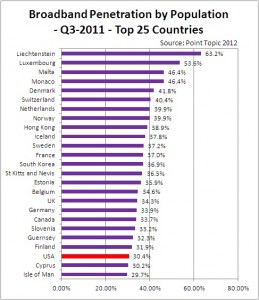What do broadband and power infrastructure have in common?
Well, maybe not much. Nevertheless, we thought this article, “Maybe it’s time to rethink how we fund broadband” in GigaOm was interesting, and could create some interesting dialogue about the future of the energy industry. The article talks about new funding mechanisms for broadband, that include communities, businesses, and public/private partnerships. Some of the challenges that broadband users face are shared by energy and power users: costly infrastructure, concerns about reliability and up-time, some questions about control and jurisdictions, among others. One notable difference– as the following chart shows, broadband adoption and penetration in the US lags… Guernsey? St. Kitt’s and Nevis… as well as some most other developed countries.

We have always been intrigued by the true potential for a decentralized energy market and the opportunity to build and operate a distributed energy system. Deregulation has extended only as far as the vertically-integrated utility, and now creates a boundary between generators, and transmission, distribution owners and of course customers. When deregulation of electricity utilities was first discussed, there was talk of deregulating all the way to the meter. It really hasn’t happened. (Some would argue that even the deregulation of utilities that we have in the Northeast, Illinois, Ohio, Texas, and California is rather limited– and brings debatable benefits to residential consumers.)
What if local communities took matters in to their own hands, perhaps led by businesses seeking greater reliability, and reduced cost of ownership? What if these local initiatives could take deregulation to the “next level” with local investments in demand management and alternative energy sources? Right now businesses, communities and residential users respond to price signals set by central ISO hourly auctions and demand response calls. What if local communities and businesses paid in to finance their own utility infrastructure– and could choose their resources differently?
Here is an interesting excerpt from the article:
Four friends in Emporia, Kan. who until several years ago held management roles in a successful small local telecom company, had become very unhappy with the poor quality of broadband in their town of 30,000. The large incumbent refused to upgrade its network to address the community’s needs. So the four started a new company – Valu-Net, LLC – with $500,000 of their own money. Then they proceeded to raise an additional $6.3 million from investors who had to put in at least $50,000 to participate…..Co-founder Rick Tidwell states, “The people who put money in … you wouldn’t expect to have this much to invest. There were small business owners, farmers who’d done well. Mostly average Emporia residents who invested because they believe in the founders and believe that it [the network] eventually helps the community.
This is a great story– it seems the keys to making it work include all of the major business questions: control, transparency, service, cost. For gas and power, this concept immediately raises a lot of questions– who pays? Who maintains? How? It sounds a lot like a municipal energy system– which is not necessarily what we had in mind. As soon as you get to the detail of business models, and practical implementation, the concept gets foggy. But it is interesting to consider the common opportunity and challenge presented by the information superhighway and the electric power system of the future.
